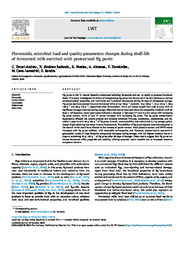Please use this identifier to cite or link to this item:
https://hdl.handle.net/11000/35051Full metadata record
| DC Field | Value | Language |
|---|---|---|
| dc.contributor.author | Teruel Andreu, Candela | - |
| dc.contributor.author | Jiménez-Redondo, Nuria | - |
| dc.contributor.author | Muelas, Raquel | - |
| dc.contributor.author | Almansa, A. | - |
| dc.contributor.author | Hernández, Francisca | - |
| dc.contributor.author | Cano-Lamadrid, Marina | - |
| dc.contributor.author | Sendra, Esther | - |
| dc.contributor.other | Departamentos de la UMH::Producción Vegetal y Microbiología | es_ES |
| dc.date.accessioned | 2025-01-20T18:58:44Z | - |
| dc.date.available | 2025-01-20T18:58:44Z | - |
| dc.date.created | 2024-10-21 | - |
| dc.identifier.citation | LWT - Food Science and Technology. Volume 211, 1 November 2024, 116918 | es_ES |
| dc.identifier.issn | 0023-6438 | - |
| dc.identifier.issn | 1096-1127 | - |
| dc.identifier.uri | https://hdl.handle.net/11000/35051 | - |
| dc.description.abstract | Fig puree is rich in natural bioactive substances including flavonoids and can be useful to produce functional foods. This study investigated the effects of incorporating fig puree into fermented milks formulations on various physicochemical properties, and nutritional and functional compounds during 30 days of refrigerated storage. Fig puree was incorporated into cow fermented milks at 0 g 100 g−1 (control), 10 g 100 g−1, 20 g 100 g−1, 30 g 100 g−1 and 40 g 100 g−1, respectively after fermentation. Initial pH values ranged from 4.48 to 4.84, with no significant changes observed during storage. Microbial counts remained above the acceptable threshold until 30 days in refrigeration. Color parameters indicated a decrease in lightness (L∗) and hue (h) values with increasing fig puree content, while a∗ and b∗ values increased with increasing fig puree. The fig puree concentration dependently affected the texture analysis and revealed enhanced firmness, consistency, cohesiveness, and viscosity in yogurts with 40 g 100 g−1 of fig puree. Overall, texture stability was maintained during storage period, though slight softening was noted in some formulations. The addition of fig puree reduced syneresis compared to the control which could be attributed to the increase of pectin content. Total phenolic content and DPPH values increased with fig puree addition, with detectable anthocyanins and flavonols, predominantly quercetin-3-galactoside. Levels of these bioactive compounds increased during storage, with the highest amounts found in yogurts containing 40 g 100 g−1 of fig puree after 30 days of storage. These results suggest that fig puree enhances fermented milks properties and stability, offering potential health benefits due to increased bioactive compound content | es_ES |
| dc.format | application/pdf | es_ES |
| dc.format.extent | 10 | es_ES |
| dc.language.iso | eng | es_ES |
| dc.publisher | Elsevier | es_ES |
| dc.rights | info:eu-repo/semantics/openAccess | es_ES |
| dc.rights | Attribution-NonCommercial-NoDerivatives 4.0 Internacional | * |
| dc.rights.uri | http://creativecommons.org/licenses/by-nc-nd/4.0/ | * |
| dc.subject | Flavonoids | es_ES |
| dc.subject | Revalorization | es_ES |
| dc.subject | Lactobacillus | es_ES |
| dc.subject | Streptoccocus | es_ES |
| dc.subject | Ficus carica | es_ES |
| dc.title | Flavonoids, microbial load and quality parameters changes during shelf-life of fermented milk enriched with pasteurized fig purée | es_ES |
| dc.type | info:eu-repo/semantics/article | es_ES |
| dc.relation.publisherversion | https://doi.org/10.1016/j.lwt.2024.116918 | es_ES |

View/Open:
Flavonoids, microbial load and quality parameters changes during shelf-life of fermented milk enriched with pasteurized fig purée.pdf
1,45 MB
Adobe PDF
Share:
.png)
